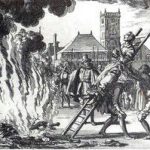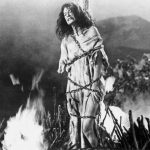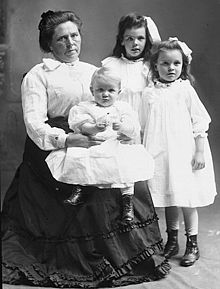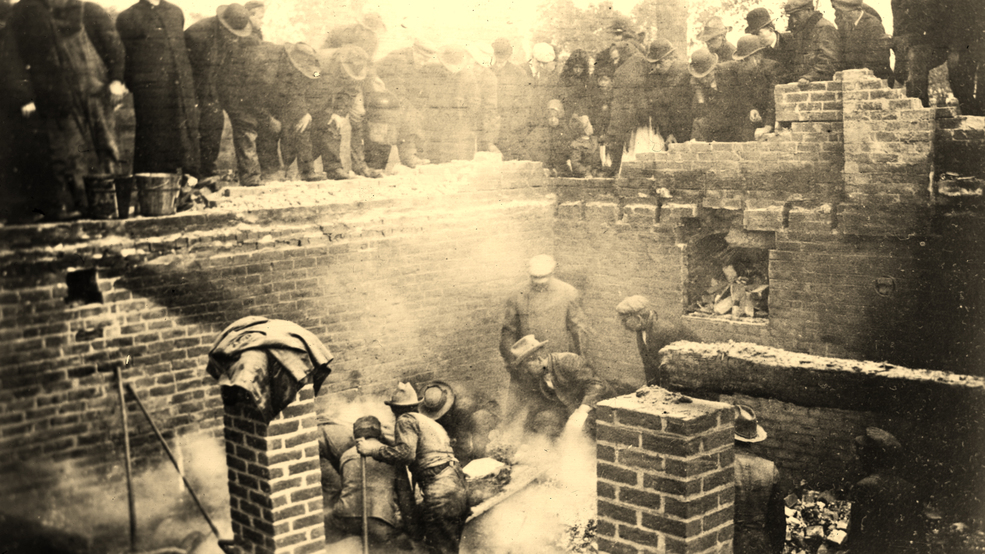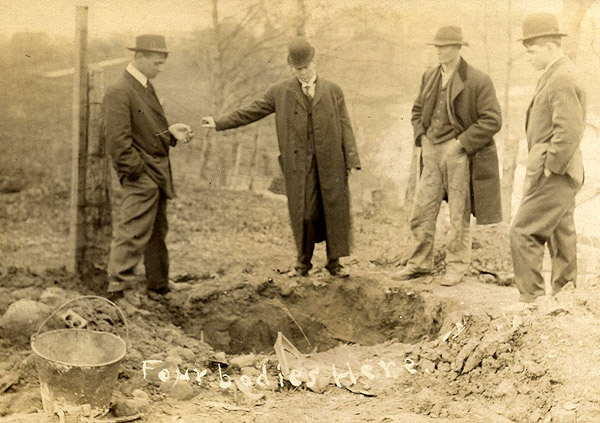Hello Herstory Heros!
Welcome to Episode 2 of our spooky ladies. This time we dive into witches and poisoners so strap in and strap on for some horrific fun.
- Version of a witch burning
- Image of burning at the stake
Name: Malin Matsdotter
Dates: 1613 – 5 August 1676
What she did: She was a witch!
- Malin Matsdotter was of Finnish heritage: she herself later stated in court protocol that she originally learned her prayers in the Finnish language.
- She married Erik Nilsson, who worked within the manufacture of nails and other metal threads, and had two daughters with him: Anna Eriksdotter and Maria Eriksdotter.
- In 1668, her spouse was executed for having had intercourse with a cow. He had been reported by their eldest daughter Anna, at that time thirteen years old.
- Malin Matsdotter remarried a man by the name Anders Arendtsson.
- After her remarriage her daughters left home, stating the frequent arguments between her and her new spouse as a reason.
- Very little is known about Malin Matsdotter, other than fragments that came forward during her trial, which was also not much.
- Her profession is unknown: she is mentioned to have been active as a midwife at one occasion, but it is not known whether it was her regular profession.
- Though described as poor, in 1676, she owned her own house in Mariaberget in Stockholm, and she had been hired as a midwife by Anna Zippel (also accused in the same witch trial).
- In court protocol she is referred to by the sobriquet “Rumpare Malin”: the meaning of the word “Rumpare” is unknown, but it is similar to the term “Rumpoxe”, which was a contemporary pejorative used for “stupid” people.
- Background:
- Since 1668, a national witch hunt raged through Sweden since the accusation of Märet Jonsdotter by Gertrud Svensdotter in Dalarna, resulting in the establishment of witch commissions around the nation and execution of about 280 people, accused of abducting children to the Witches’ Sabbath of Satan in Blockula and often judged upon the testimonies of children.
- The Swedish witch frenzy reached its peak with the Torsåker witch trials in 1675, and reached the capital of Stockholm the same year with the Gävle-Boy, which lead to a witch trial in the congregation of Katarina Church, known as Katarina witch trial, were children and teenagers of the Katarina parish started to follow the example of the Gävle Boy by pointing out women for abducting them to Satan.
- By May 1676, the Katarina witch trial had resulted in the execution of the sisters Brita and Anna Zippel, Maria Jönsdotter, Margareta Matsdotter and Anna Persdotter Lärka, as well as death in prison by suicide of Anna Månsdotter and Karin Johansdotter.
- Trial
- In July 1676, Malin Matsdotter was reported for witchcraft by her nineteen-year-old daughter Maria Eriksdotter.
- Her reported stated: “The true daughter of Rumpare Malin, Maria Eriksdotter age nineteen, were called upon and confessed that she had the same night been abducted by Anna Wife of Staffan, who sells beer at Dalarö, to whom she had been lost at games by her mother […] Last Easter Evening her mother allegedly said to her: My daughter do you wish to follow me and we will make people out of you […] thereafter she began to take her every night [to Blockula] […] the second time upon a man. Confessed aside that her mother had always had a bad language, cursed and used ugly words, particularly on great holy days.”
- Malin Matsdotter were questioned and cautioned to tell the truth. She was thoroughly questioned regarding her religious instruction. When asked to recite the Creed, she answered that she could not bother to read and barely knew the Lord’s Prayer.
- Her language difficulties attracted attention when she had difficulty reading the prayers the court instructed her to: she did not know them herself, and even had trouble repeating them when they were read to her.[
- The court noted that she hesitated in a suspicious way when she was to repeat the prayers word by word. The fact that she had trouble reading was in fact uncommon in 17th-century Stockholm: since the Swedish Church Ordinance 1571, every citizen regardless of class or sex was by law required to be able to read, so that they may be able to read the bible.
- Her daughter Maria Eriksdotter testified that Malin took both her and several children to Satan in Blockula, and that Satan himself, “The Mean One” appeared in court, long, black and with horns, standing by her mother, holding her skirt and whispered in her ear never to confess.
- Malin was ordered by the court to fall on her knees and pray to be able to confess, and after having obeyed, her daughter stated that she could no longer see the Devil.
- Ten year old boy Matthias Wallendorph and seven-year-old girl Margreta Jöransdotter both testified to have been abducted by Malin to Blockula, and they supported Maria Eriksdotter in her words that Satan appeared behind Malin, cautioned her not to confess.
- The married woman Gertrud Mattsdotter testified that Malin had abducted her children to Satan sixteen times and that Malin had abducted them fourteen times while in prison.
- The children of Gertrud Mattsdotter testified that they had been beaten by Malin to prevent them from testifying, and Gertrud Mattsdotter testified that she had seen her children endure fits while being supernaturally beaten by Malin from prison, and that she would rather see them died than suffer, and that she would kill Malin herself if she was not executed.
- Malin’s older daughter Anna Eriksdotter supported her sister’s testimony that their mother took them to Satan, but when she stated that she herself had started to abduct children there herself, she was also placed under arrest.
- The court did ask Maria Eriksdotter if she was trying to have her mother executed in order to inherit her house, but she denied it.
- Malin Matsdotter was asked by the court to fall upon her knees and repeat a prayer read to her, but she did not succeed before her 11th attempt, which was given great importance by the court.
- The court was convinced of her guilt by the testimony of her own daughters combined with her lack of religious knowledge and difficulty to read prayers.
- She commented the testimony of her daughters with the words: “My God, let them go there [Blockula] for ever”, and stated that she did not mind dying when her own daughters testified against her.
- Her daughters were questioned again and stood by their testimonies, as Malin stood by her denial.
- Such firm denial was often regarded as a sign that the Devil assisted the witch to withstand interrogations. She accused her daughters of a bad lifestyle and when the court asked her to specify, she answered with such language that her answer was in fact never written down in the court protocols, because they were “to offence to decent ears”.
- Execution
- On 16 July 1676, Malin Matsdotter was judged guilty as charged by a unanimous court on the testimonies of her daughters and sentenced to be executed.
- The method of execution was the subject of debate in the royal witchcraft commission, who was to decide between three alternatives; the first was the customary execution by decapitation followed by public burning of the corpse; the second was that she would be subjected to torture prior to the first alternative; and the third alternative was that she would be executed by being burned alive. The last alternative was given the majority vote.
- She was to have a bag of gunpowder secured around her neck to make her death quicker. Because the court was convinced of her guilt, her refusal to admit guilt made her position worse on the eyes of the court.
- The method of execution make the case of Malin unique in Sweden.
- She was the only person of the almost 300 people executed during the great Swedish witch hunt of 1668–76, to be executed by being burned alive instead of by decapitation followed by public burning of the corpse, which was the normal execution for sorcery in Sweden.
- Though several crimes formally allowed for public burning as method of execution, this actually meant that the condemned be “executed and burned”, which meant that they were first executed by decapitation or hanging, after which their corpse was publicly burned: the method of burning someone still alive is only known to have been used in the country a very few times before, and the verdict was therefore controversial.
- Malin was the last person to be executed by burning in the capital of Stockholm, and the second to last to be executed by burning in Sweden.
- No other person executed for sorcery in Sweden is confirmed to have been burned alive.
- The method of execution by burning had been debated by the commission in Stockholm previously during the Catharina witch trial of 1675–76 and actually given to an earlier condemned, Anna Lärka, for her refusal to admit guilt, but it was retracted when she finally did so.
- The execution was performed in the square of Hötorget in Stockholm the 5 August 1676. Malin was to be executed alongside Anna “Annika” Simonsdotter Hack, known as “Tysk-Annika”, who had also been accused and sentenced to death on the testimony of her own children, but was to be executed the normal way by decapitation before burning.
- The contrast between the behavior of the two have been noted.
- Anna Simonsdotter was described as full humility and respect and behaved as was expected by her, and though she did not directly say that she was guilty, she behaved as was expected of her, and “by her remorse, by her psalms, and by falling on her knees and lifting her head and her hands to the sky, confirmed the justice in the verdict and the justice in the world”.
- According to contemporary witnesses, Malin Matsdotter behaved with great dignity and courage during her execution. When asked to take the hand of her daughter to make peace with her before death, she refused. She “did not seem to fear death much, courageously mounting the stake”, and even the official execution protocol noted that she “was very tough”.
- She spoke calmly with the executioner, “allowing him to fasten her with iron by her hands and feet”, and the bag of gunpowder was placed around her neck to hasten death. She talked back to the priests with her head held high when they pleaded with her to acknowledge her sin, maintaining her innocence.
- When her daughter cried out and appealed to her to admit her crimes “Malin delivered her daughter in the hands of the Devil and cursed her for eternity”.
- The execution in itself was described: “But though all of this was both horrifying and pathetic to look upon, those who suffered death did not shed one tear but stood by their standpoint of innocence with an unnatural courage”.
- Tradition claims that Malin Matsdotter did not scream but died in silence, in accordance with contemporary view that witches felt no pain.
- Aftermath
- The execution of Malin did in fact signify the end of the Katarina witch trial in Stockholm and the end of the national 1668–76 witch hunt in Sweden.
- Some of the judges in the commission, notably Urban Hjärne and Eric Noraeus, begun to express skepticism toward the child witnesses and instigate a different interrogation technique against them by asking them to repeat their testimonies rather than to affirm their already given testimonies.
- This was particularly brought about since the child witnesses had started to accuse people from the upper classes, such as the Captains wife Margareta Staffansdotter Remmer and Maria Sofia De la Gardie.
- This resulted in the break down of one witness, Annika Thomsdotter, in court on 11 September 1676, which snowballed into other witnesses to retract their testimonies and blamed the leading witnesses, the Gävle Boy, Lisbeth Carlsdotter and the Myra Maids to have convinced them to perjure themselves.
- Seventeen child- and teenage witnesses admitted perjury. This efficiently discontinued the Katarina witch trial. The remaining accused, Margareta Staffansdotter Remmer, Karina Ambjörnsdotter and Margareta Matsdotter Dufva, were freed, and the courts instead prosecuted the witnesses for perjury, leading to both executions and physical punishments.
- The leading perjurers, the Gävle Boy, Lisbeth Carlsdotter and the Myra Maids , were executed on 20 December 1676.
- Annika Zippel was sentenced to be whipped and died during the punishment.
- The oldest daughter of Malin Matsdotter, Anna Eriksdotter, was herself under arrest after having stated during her testimony against her mother that she had herself begun to follow her example by abducting children to Satan. Imprisoned, she reported that she heard her mother call for her in her dreams, pinch her and ask her to “come as soon as possible” because she had accused her of witch craft. Anna Eriksdotter was, as the other remaining accused, freed from the charge of witch craft, but sentenced to be whipped for perjury. During the whipping, the crowd attacked the guards performing the whipping by throwing stones.
- Malin’s younger daughter Maria Eriksdotter was given an official warning to make amends for her sin of perjury.
- Legacy
Malin Matsdotter is the role model for the novel Djävulens Märke by Magnus Nordin. - She is a central figure in the children’s book series Jakten på Jack by Martin Olczak.
![]()
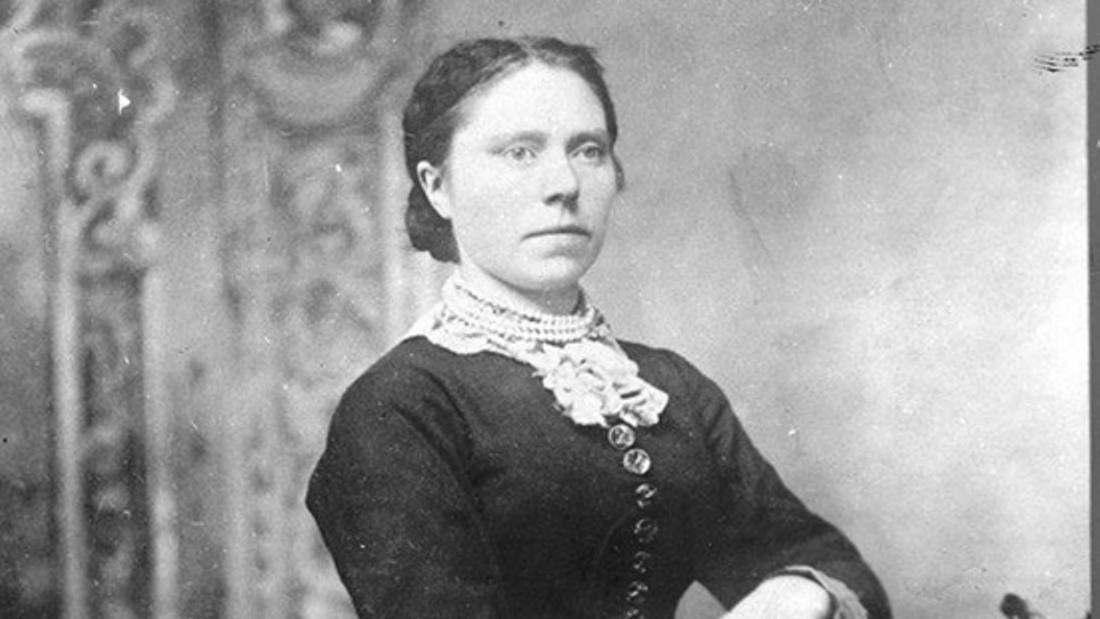
Belle Gunness as a young woman LAPORTE COUNTY HISTORICAL SOCIETY MUSEUM
- Gunness with her children, c. 1908
- Gunness’s three children and the body of a headless woman were found in the basement of Gunness’s house after a fire. Some believe the body wasn’t hers, and that she got away // LaPorte County Historical Society and Museum
- “Four bodies here” // LaPorte County Historical Society and Museum
Name: Belle Gunness
Dates: November 1859-????
What she did: Mass Murderess
- Belle came from humble beginnings. Born in November of 1859 as Brynhild Paulsdatter Storset, Belle grew up in the small poor village of Selbu in Norway.
- She was the youngest of 8 and her father worked
as a stonemason. - There’s not a lot of information regarding Belle’s early life but there is a story that seems to persist. In 1877, when Belle was around 18 years old, she found herself pregnant. She attended a local country dance where she was attacked by a man and kicked in the abdomen, causing a miscarriage.
- The man
who attacked her was from a wealthy family, so naturally, he faced no consequences. Friends noticed that Belle’s personality changed dramatically. - However, karma would come for the man as he died shortly after the attack of stomach cancer. In retrospect, there may have been more tangible and dangerous forces at work.
- Belle took a job on a farm for 3 years to save money for a trip to America. Belle did well working on the farm. Standing at 5’8” and weighing between 180-200 pounds, Belle was a strong, imposing wall of a woman.
- In 1881, Belle sailed across the Atlantic and began going by her more Americanized name, Belle. Finding work as a servant, Belle eventually found her way to Chicago, IL where she married Mads Ditlev Anton Sorenson in 1884.
- Two years later, the couple opened a candy shop.
- The two had four children: Caroline, Axel, Myrtle, and Lucy. Caroline and Axel didn’t survive infancy, allegedly dying of acute colitis. This caused severe fevers, nausea, diarrhea, and lower abdominal pain. It wasn’t uncommon for children to die in infancy at the time, but it’s worth noting that the symptoms of acute colitis are the same as different kinds of poisoning.
- Worth noting is that both children had
hefty life insurance policies taken out so each of their deaths resulted in a nice pay-day. This must have helped because their candy shop wasn’t doing well. Lucky for Belle, the heavily insured shop mysteriously burned down, resulting in another windfall. Their insured house also burnt down. What an incredible coincidence! - At some point between this time and 1900, Belle and Mad adopted a 10-year-old girl named Jennie Olsen. So we have Belle, her husband, Mads, their surviving children Myrtle and Lucy, and their adoptive daughter Jennie.
- The family became a bit smaller when Mads died on July 30, 1900. He died on the day in which two life insurance policies which Belle had taken out on him
overlapped. - The very next day, Belle applied for the payout.
- Mad had been struggling with illness and Belle had been treating him with quinine powder.
- A doctor who had visited Mads said he was suffering from strychnine poisoning. However, the family doctor had been treating Mads for an enlarged heart so he basically ignored the first doctor’s conclusion and deemed that it was an enlarged heart which caused his death.
- Mad’s family didn’t buy it. They demanded that there be an investigation and that his body be exhumed, but there’s no record as to whether or not this happened. If it did, not much came of it. Because the death was not seen as suspicious so an autopsy was not required and Belle collected on both policies which came out to be $8,500 which would be over $200,000 in today’s money.
- She used the money to buy a farm on the outer edges of La Porte, Indiana where she moved with her three children.
The farm consisted of a house, acres of land, and a boat and carriage house. Curiously, the boat and carriage houses burned down shortly after Belle moved in. - While preparing for the move out to the farm in 1901, Belle met and married widower and farmer, Peter Gunness who was from Indiana. Peter had two daughters of his own.
- The family of seven again began to dwindle. It started with Peter’s infant daughter. She died while alone in the house with Belle. It’s unknown what caused the infant’s death but, again, the death of an infant was not uncommon so I can imagine no one was asking questions.
- Peter met his end under bizarre circumstances. Belle had two stories about how Peter died.
- 1. First, she said he was reaching for his slippers which were next to the kitchen stove. He knocked over a pot of brine which was boiling on the stove which scalded him, to death.
- 2. Then, Belle claimed that a meat grinder fell from a high shelf, hitting Peter in the head and killing him.
- At this point no one should be surprised that Peter’s life was insured, allowing Belle to collect $3,000 which is over $85,000 in today’s money.
- Peter’s death rose suspicions from locals. Peter was an experienced farmer and butcher and the idea that he would have been so clumsy combined with the inconsistencies in Belle’s story didn’t sit right with most.
- The coroner determined that Peter had in fact been murdered and asked a coroner’s jury to investigate further.
- Oh, did I mention that Belle’s adopted daughter Jennie straight up said that Belle had killed Peter? The 14-year-old had told her classmate “My mama killed my papa. She hit him with a meat cleaver and he died. Don’t tell a soul.”
- When Jennie was brought before the coroner’s jury, she denied having said anything. Then Jennie stopped showing up to school. Belle told people she had gone to Lutheran school in Los Angeles or to a ladies finishing school.
- Belle convinced the coroner that she had nothing to do with Peter’s death and the whole thing just kind of blew over.
- Peter’s brother took Peter’s surviving daughter to Wisconsin- effectively saving her life. Then, Belle gave birth to a son, presumably Peter’s, named Philip.
- Belle and her three remaining children continued to live and work on the farm. They were later joined by a man by the name of Ray Lamphere when Belle hired him on as a farm-hand.
- Now, running a farm by yourself is hard work, so Belle went looking for a new husband. Back in the early 1900s there was no tindr or Match.com, so lonely singles would post ads in the newspaper to attract a match.
- Belle submitted ads in the matrimonial columns of daily newspapers in Chicago and other Midwestern cities. The ad read:
- “Personal- comely widow who owns a large farm in one of the finest districts in La Porte County, Indiana, desires to make the acquaintance of a gentleman equally well provided, with view of joining fortunes. No replies by letter considered unless sender is willing to follow answer with personal visit. Triflers need not apply.”
- So basically, she’s asking for wealthy, eligible men to visit her rural farm CASH IN HAND.
- One of the men who responded was John Moe who traveled from Elbow Lake, MN with $1,000 in cash to help Belle pay off her mortgage.
- Belle played it chill and told neighbors that John was her cousin. Within a week, John was missing and he wouldn’t be the last.
- It’s hard to know exactly how things transpired on Belle’s farm as more and more suitors traveled to and disappeared from her farm. She kept the shutters perpetually closed and was only spotted working at night in the pig pen.
- George Anderson answered Belle’s ad, traveling from Tarkio, Missouri to Belle’s farm. However, he did not bring any money with him. George and Belle had dinner and when she asked about money to help pay her mortgage, George said he would help financially if they were married. George spent the night on the farm, but awoke in the middle of night to Belle, this wall of a woman, standing over him holding a candle. According to George she had a dark, angry look on her face. When George awoke, Belle fled the room without a word. George caught the first
train back to Missouri. - One suitor, Ole B. Budsberg from Iola Wisconsin was last seen at the La Porte Savings Bank where he mortgaged his land back in Wisconsin, leaving with thousands of dollars in cash.
- During this period, Belle gained a trunk obsession. She was regularly ordering trunks to be delivered to the farm. The trunk delivery guy would later remark how she would throw two trunks over her shoulders and carry them like they weighed nothing.
- Before suitors would come to Belle’s farm, they would carry on a correspondence via letters. A letter from Belle to one of her victims, Andrew Helgelien of Aberdeen South Dakota, was found in his home after he had disappeared. It read:
“To the Dearest Friend in the World: No woman in the world is happier than I am. I know that you are now to come to me and be my own. I can tell from your letters that you are the man I want. It does not take one long to tell when to like a person, and you I like better than anyone in the world, I know. Think how we will enjoy each other’s company. You, the sweetest man in the whole world. We will be all alone with each other. Can you conceive of anything nicer? I think of you constantly. When I hear your name mentioned, and this is when one of the dear children speaks of you, or I hear myself humming it with the words of an old love song, it is beautiful music to my ears. My heart beats in wild rapture for you,
My Andrew, I love you. Come prepared to stay forever.” - This was the last letter Andrew received before he flew to the Indiana farm with his entire savings of $2,900. He and Bell went to the local bank to deposit the money. A few days later, Belle made two bank visits, depositing $500 in one bank and $700 in another. Andrew was nowhere to be found.
- Earlier I mentioned farm-hand Ray Lamphere. He was the only other adult living on the farm and things had been fine for a while. It’s said that Ray was in love with Belle and would do whatever she asked.
- Naturally, men flooding the farm to court Belle didn’t sit too well with Ray. On February 3, 1908, Belle fired Ray for consistently throwing fits and making scenes. Then, she went to the local courthouse to tell authorities that Ray was insane and a danger to the public. She was able to convince them to hold a sanity hearing to determine if Ray really was a threatening madman. They determined he was sane and let him go.
- Then Belle had Ray arrested for trespassing, saying he was a threat to her family.
That was not the end. Ray began frequenting the farm, threatening Belle and he would talk to neighboring farmers, dropping hints about what had been happening on Belle’s farm. He said “Helgelien (Andrew who I just mentioned) won’t bother me no more. We fixed him for keeps.” Ray couldn’t have been more wrong. - Andrew’s brother, Asle, naturally grew concerned because he hadn’t heard from his brother. He started a correspondence with Belle, asking where his brother was. Belle wrote that Andrew wasn’t at his farm and probably went off to Norway.
- Asle said there was no way he would have done that and that he was going to come looking or his brother in La Porte. Bell, who is getting way too big for her britches, basically challenges Asle to come looking for his brother and offers
to help, but if she’s going to help, Asle had better compensate her for her efforts. Asle began planning his trip to La Porte. - With the threat of Asle’s visit and Ray’s increasingly erratic behavior, Belle could feel the walls closing in. Belle had hired Joe Maxson to replace Ray as a farm-hand in February of 1908, shortly after she had fired Ray. On April 28, 1908, Joe woke up to the smell of smoke. Surprise, surprise, the house was on fire!
- Joe yelled for Belle and her three children, Myrtle, Lucy, and Philip but got no response. To escape the flames, Joe had to jump out his 2 nd floor bedroom window.
- He ran into town to get help but by the time it arrived, all that was left was the burned out shell of the house.
- Her children, Myrtle, Lucy, and Philip were found, still in their beds. A fourth body was found. It was that of an adult woman, but she was curiously missing her head.
- Belle had been talking to people in town about Ray’s erratic behavior and his explicit threats to burn her house down, so naturally, authorities tracked him down.
- The first thing Ray did when confronted by authorities was to ask “Did Widow Gunness and the kids get out all right?” but still claimed to have nothing to do with the fire. However, a local boy had witnessed Ray running from the burning house and Ray was arrested for arson and murder.
- When authorities investigated the house, things only got weirder.
- The headless woman they found in the house was thought to be Belle until they realized that the body was only 5’3” and 150 pounds. Remember, Belle was almost 6 feet tall and 200 pounds. The woman’s body and the bodies of the three children were all determined to contain lethal doses of strychnine.
- So if the headless corpse wasn’t Belle, who was it? Ray later confirmed that Belle had lured a young woman from Chicago, promising work as a housekeeper, a few days before the fire.
- Then Asle came looking for his brother in May, saying he believed Belle had done something to him. The new handyman Joe also mentioned that Belle had asked him to dispense loads of dirt in the area where the hogs were fed to fill in deep depressions in the ground.
- With this information, authorities returned to the farm and found all of Belle’s suitors. Body upon body was recovered from the pen. The bodies of Asle’s brother, Andrew, and Jennie, Belle’s adoptive daughter who had allegedly gone off to school after talking about Belle murdering Peter, were identified.
- Belle had upwards of 40 victims and not all of them could be identified. Those who couldn’t be were buried in the pauper’s section of La Porte’s Pine Lake Cemetery. Andrew and Jennie were buried in Patton Cemetery near Peter Gunness. The headless woman was buried as Belle Gunness because they honestly didn’t know what else to do.
- Ray Lamphere was convicted of arson (but not murder because they couldn’t determine that the headless body was Belle’s) and he later confessed on his death bed that Ray had never killed anyone, but was very much aware of what Belle was doing and helped her dispose of the bodies.
- Sometimes Belle would drug her victims’ coffee then split his head with a meat chopper. Sometimes she would chloroform her victims in their sleep or poison them with strychnine. Once they were dead, she would take them to the basement and dissect their bodies, using techniques she had learned from her second husband, Peter the butcher. She would then dispose of the bodies in the hog pen, sometimes using quicklime and sometimes feeding the remains to the hogs.
- Over the years, Belle was spotted in various cities across the U.S. but was never caught.
- In 1931, over twenty years after Belle Gunness was last seen in La Porte, a woman named Esther Carlson was arrested in Los Angeles. Her crime? Poisoning her husband for the insurance money. Sound familiar?
- Esther died while awaiting trial, but when showed a picture of the woman, those who knew Belle Gunness were certain it was her.
- This is a prevailing theory, but the truth is darker. You see, Esther Carlson was a serial killer in her own right. While Belle was wrecking shit in Indiana, Esther married her first husband who died 14 years later after being poisoned. Then she killed another dude and her husband’s friend.
- There is plenty of documentation that Esther Carlson was kicking around at the same time as Belle Gunness. It’s not like she just mysteriously appeared and had no identity before 1908.
- Let’s be honest, there’s a long dark history of women poisoning their husbands with poison for insurance money. It’s basically its own crime genre.
LEGACY
- Belle is recognized as one of the most ruthless murders to have ever stalked the country. .
- Let’s talk about her victims.
- There is an ongoing effort to try and identify the victims who were discovered on the farm. In 2007, the headless woman who had been found was exhumed by forensic anthropologists from the University of Indianapolis.
- They were going to try and compare the DNA from the woman with DNA from a sealed envelope that Belle had sent to one of her victims, but there wasn’t enough DNA to discern anything.
- They are still working to find living relatives of other potential victims to compare DNA and give them back their names.
